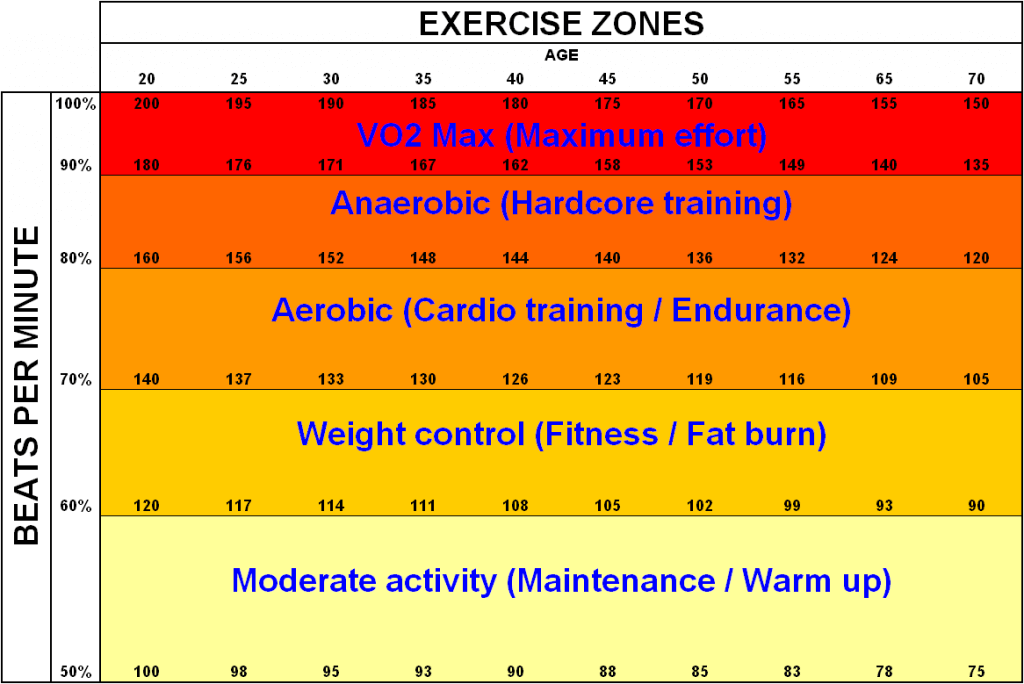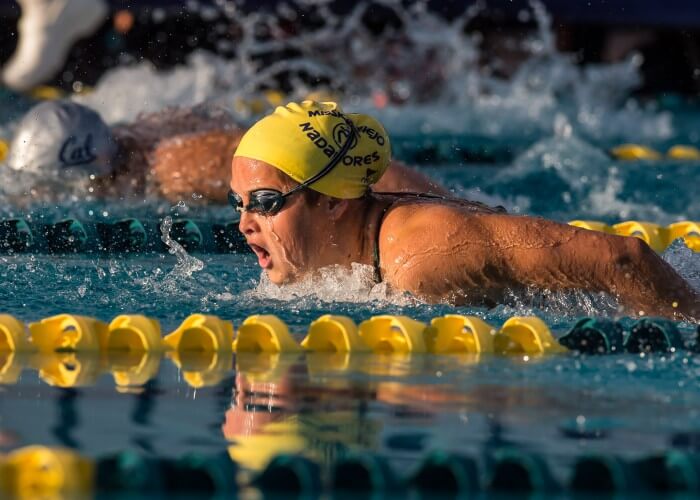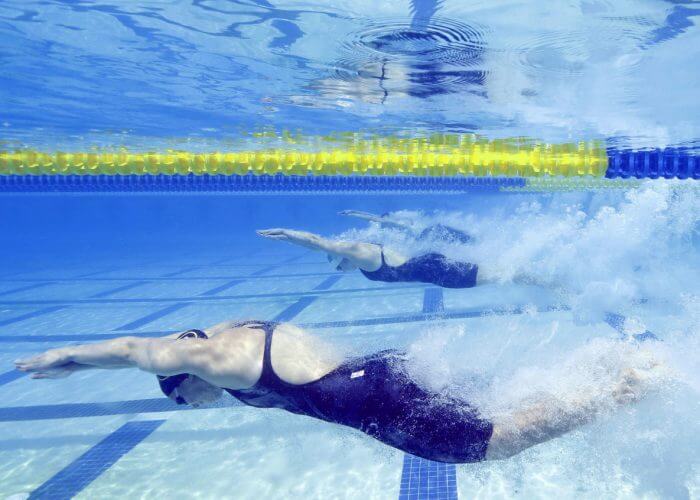How To Boost Swimming Performance Through Real Time Heart Rate Monitoring

Commentary courtesy of Vilius Stanislovaitis.
There are a lot of people out there who are avid swimmers and have taken it up as a career. Professionals know that tracking their heart rate during workouts is crucial. Moreover it’s important for those who are using swimming as a cardiovascular exercise or an effective mean to lose weight.
Measuring heart rate during the training means that you would become familiar with your own body. You would know your capacity and how your heart responds when you are aiming for more rigorous activities. And finally, using heart rate training you would significantly improve efficiency of your workout and boost your swimming performance.
The Essential Benefits of Swimming

Without a doubt, this cardiovascular activity brings immense benefits to the health of the person. Here are only a few major ones:
Improved Metabolism
Swimming impacts our body in a way which helps in the betterment of the metabolism rate. This, in turn, leads to weight reduction and utilizing the nutrients to provide energy to the body.
Production of Good Hormones
There is no doubt about the fact that swimming is a fun activity which boosts the production of those hormones which make you happy. This kind of exercise helps in giving you a more positive outlook on the world turning your personality into an optimistic one.
Enhanced Heart Health
Your heart works exactly like other muscles of your body because it is strengthened with regular exercises. Your heart’s functionality will be enhanced manifolds with the help of swimming.
Gaining Familiarity with Human Heart Rate
Your heart rate is never stable as it will increase or decrease depending on the body’s oxygen requirements. It works to maintain an equilibrium between the body’s need for oxygen and the quantity which is delivered to it. Usually, a human heart beats around 3.5 billion times in an average lifespan. These metrics will help in understanding the heart rate better.
Resting Heart Rate
When a person is in a completely resting environment and is not undergoing any stimulation or rigorous activity then his heart rate is defined as resting or basal. This also includes that there is no shock or surprise element in the present situation. A typical heart rate during this period is 60-100 beats per minute for normal people. Elite athletes can have a heart rate between 33 and 50 beats per minute.
Target Heart Rate
The target heart rate is the ideal heart rate of a normal person who is undergoing some strenuous activity. This particular heart rate enables the person to receive the most rewards during the training session and has a very positive effect on the health of the lungs and the heart. It is determined mostly by age but a number of factors including sex, previous training, and physical condition are also involved in the calculation method.
Swimmers need to be aware of the fact that their target heart rate is lower in water because of the cooling effect, buoyancy of the water and horizontal position while swimming. The University of Maryland Medical Center reports that swimmers’ target heart rates can be 12 beats per minute fewer than those who exercise on land.
Maximum Heart Rate (MHR)
This heart rate is the maximum which a person can achieve while working out given the fact that he is completely healthy. It tends to decrease with age and can be determined with a very widely used formula which is
HRmax = 220 – age
A cardiac test is highly recommended method to determine it where a person is subjected to controlled physiological stress while being monitored by ECG. When someone is planning out on a rigorous physical activity, it is always better to carry out this test in the presence of a few experts. This will help in getting knowledge about any of the potential risks involved in the activity.
Understanding the Heart Rate Zones
With the help of heart rate monitors, one can easily gain familiarity with the magnitude of effort one is putting in any physical activity and how it is affecting the heart rate. Following are the different workout intensities which provide an insight on different heart zones.
Moderate to Easy Swimming (50 – 60% of MHR)
This zone is ideal for people who already have some health issues and imparting more effort will result in deterioration of their health.
Fitness Swimming (60 – 70 % of MHR)
The fat levels of the body are reduced with this making this the ideal heart rate zone to lose weight and improve the health of your body.
Aerobic Swimming (70 – 80 % of MHR)
For experienced athletes, this one is ideal because it helps in improving the endurance and strength of the body.
Anaerobic Threshold Swimming (80 – 90 % of MHR)
This zone tends to improve the working of the cardiovascular system and increases the lactate tolerance which means that you will be able to fight fatigue better.
The Red Zone (90 – 100 % of MHR)
Remember that this one should be performed in short bursts and is only recommended for highly experienced professionals.
Importance of Using a Heart Rate Tracker

Photo Courtesy: Bob Stanton-USA TODAY Sports
Whether you are indulged in strength training, endurance, cardio, or any other kind of activity including swimming, monitoring the heart rate in real time is crucial. Currently, there are a number of heart rate trackers available in the market and we find that most of that are wrist wears. These kind of trackers suit perfectly the cyclists and the runners but are not at all ideal for the swimmers. While swimming, it is inconvenient and almost impossible to monitor the heart rate with the wrist wears: wrist is on the move while goggles could be misty. Therefore, something more practical is needed for this.
Recent research, done by interviewing professional swimmers and swimming coaches showed that the most practical heart rate monitor device is eyewear that displays color-coded information in swimming goggles in real time.
Ovao is a company that is currently in the last stages of developing the heart rate monitor and personal heart rate trainer for swimmers. Aldas Juronis, CEO of Ovao advises that this device will help significantly improve swimming performance by guiding throughout a workout and indicating when to increase or decrease swimming intensity according to a pre-set heart rate training program.
All swimming and dryland training and instruction should be performed under the supervision of a qualified coach or instructor, and in circumstances that ensure the safety of participants.




Edwina Ed….Edrin Rafael Walcott
CG ???
Lucy Towle
When doing a correct calculation you must first include your resting pulse rate as well and the MHR.
While the information in this piece may be useful, the last part of this article is clearly an advertisement for a commercial product. A distinction should be made between articles which present solely information of use and those which use an information prologue (accurate or not) as a lead in for advertising a product for sale.
Such items can easily be confused by less sophisticated or younger readers as an endorsement of a product by Swimming World which is of benefit to the athletes who uses it. For clarity and honesty, advertisements should be labeled as such somewhere, lest a mistaken conclusion be drawn by readers. Swimming World owes at least this this to the readers of the on-line publication for clarity and ethical reasons as well.
First off, Jim Griffin’s post about mixing (?) articles with product promotions should be not be ignored by Swimming World.
I’ve always exercised for fitness and fun and I never liked the idea of heart rate monitors. I’ve trained extremely hard and understood my limits extremely well without ever having used a heart rate monitor. I’ve read plenty about training methods, VO2 max, and anerobic threshold and lactate threshold (if it exists as theorized), and I am well aware of my heart rate as one can be without monitoring it. Much of my learning was with respect to cycling. I finally ditched my computer for good when I realized it was only a distraction, and not even productive. I am not suggesting that anyone else feel the same way. But if you do, there are a lot of us. A lot of us get of of breath and we didn’t need to know the precise details; relative measurements are enough. If I was on a team or otherwise in serious competition, I would use the technology. But I’m not and I am maximizing my goals, including enjoyment, without it.